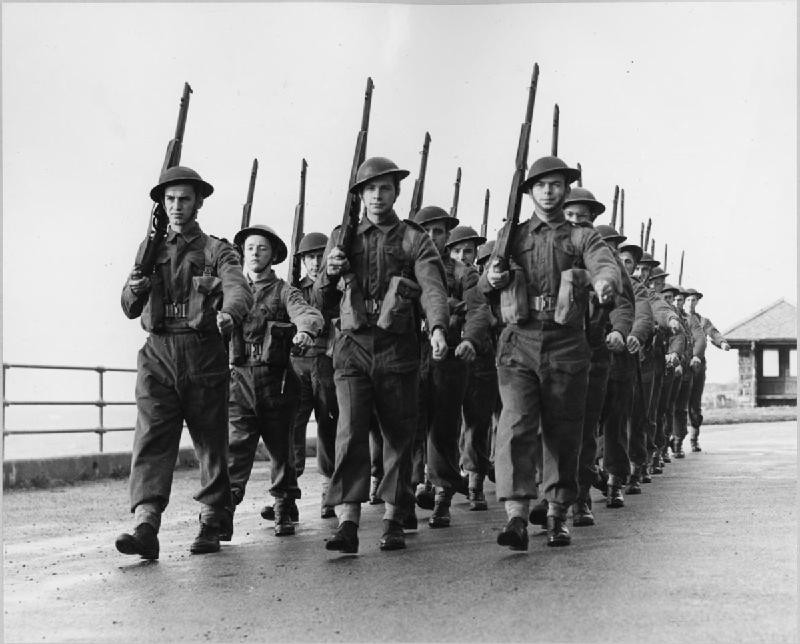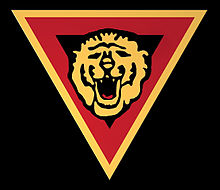 . More than one hundred Luxembourgers volunteered for the 1st Belgian Infantry Brigade ‘Brigade Piron’. Most of them constituted the ‘Luxembourg Battery’, an artillery unit (troop C) composed of four 25 pounder (artillery guns) which were named after the Luxembourg princesses. Brigade Piron had fought in the Battle of Normandy and took part in the liberation of Belgium and the Netherlands.
. More than one hundred Luxembourgers volunteered for the 1st Belgian Infantry Brigade ‘Brigade Piron’. Most of them constituted the ‘Luxembourg Battery’, an artillery unit (troop C) composed of four 25 pounder (artillery guns) which were named after the Luxembourg princesses. Brigade Piron had fought in the Battle of Normandy and took part in the liberation of Belgium and the Netherlands.
As a reaction to the introduction of forced labour service by the Nazis in 1941, the first young men decided to leave Luxembourg to join Great Britain’s forces to fight against Hitler. Many of them were arrested on their way through France and so volunteered for the French Foreign Legion.
From the second half of 1942 onwards, after the introduction of forced military service in the German Army, the number of young men leaving Luxembourg grew further. Deserters and prisoners of war looked to join the Allied forces to participate in the fight for the liberation of Europe.
After the landing of the Allies in North Africa, the French Government allowed young people from Luxembourg to join the 1st Belgian Infantry Brigade, where they formed troop C in the Artillery Unit ‘Luxembourg Battery’. A total of 98 Luxembourgers were integrated into this unit until June 1944. In September 1944, a further 46 volunteers from Luxembourg joined the Brigade and became part of the 3rd Infantry Company.
On 7 August 1944, the 1st Belgian Infantry Brigade set foot on the soil of Normandy. They were under the command of Lieutenant Colonel J.B. Piron. The Brigade Piron’ participated in the battles in Normandy, liberating Trouville, Deauville and Honfleur. From 31 August to 1 September they crossed the River Seine and progressed towards Brussels, which was liberated on 4 September. Pushing North, the ‘Brigade Piron’ eventually liberated the city of Thorn in the Netherlands. In 1945, the Brigade took part in the occupation of the Ruhr area (British sector).
In June 1945, the Luxembourgers were demobilised and finished their service with a military parade in front of thousands of their compatriots in Luxembourg city. Whilst the Brigade lost 80 members during the fighting campaigns, no Luxembourger lost their life.
 ![r/ForgottenWeapons - FN’s first submachine gun - the toggle-action Heinemann SMG (1935)] Year:
![r/ForgottenWeapons - FN’s first submachine gun - the toggle-action Heinemann SMG (1935)] Year:
1935
Cartridge:
7.63x25mm
Length:
N/A Weight:
N/A Magazine:
40 rounds Rate of Fire:
N/A Designer(s):
Karl Heinemann Manufacturer(s):
Fabrique Nationale d’Armes de Guerre Notes:
Licensed version of Heinemann MP 32.
Heinemann MP-32

Designed by Karl Heinemann, the MP-32 (or Model 32) was a toggle-joint 9mm submachine gun with a very heavy barrel. Only a handful were made, until in 1935 FN Herstal started manufacturing it under license. They re-chambered it for 7.63mm with 20 or 40-round magazines. It attracted few buyers.
The Independent Belgian Brigade (Dutch: 1e Infanteriebrigade ”Bevrijding” , lit. ‘1st Infantry Brigade “Liberation”’) was a Belgian and Luxembourgish military unit in the Free Belgian forces during World War II, commonly known as the Piron Brigade (Brigade Piron ) after its commanding officer Jean-Baptiste Piron. It saw action in Western Europe and participated in the Battle of Normandy, the Liberation of Belgium, and fighting in the Netherlands over 1944-1945.
 . The Belgian Brigade participated in Operation Paddle, Clearing the Channel coast from 17 August with British and Dutch (Prinses Irene Brigade) troops of the 6th Airborne Division. Merville-Franceville-Plage was liberated in the evening, Varaville on 20 August. The brigade’s armoured vehicles were detached to assist British units. Dives-sur-Mer and Cabourg were taken on the morning of 21 August and Houlgate in the afternoon. The brigade took Villers-sur-Mer and Deauville on 22 August, and Trouville-sur-Mer and Honfleur at the mouth of the Seine on 24 August. The bridge connecting the communes of Deauville and Trouville-sur-Mer was renamed to “Pont des Belges” and still bears a commemoration[3] to the brigade which liberated the communes.
. The Belgian Brigade participated in Operation Paddle, Clearing the Channel coast from 17 August with British and Dutch (Prinses Irene Brigade) troops of the 6th Airborne Division. Merville-Franceville-Plage was liberated in the evening, Varaville on 20 August. The brigade’s armoured vehicles were detached to assist British units. Dives-sur-Mer and Cabourg were taken on the morning of 21 August and Houlgate in the afternoon. The brigade took Villers-sur-Mer and Deauville on 22 August, and Trouville-sur-Mer and Honfleur at the mouth of the Seine on 24 August. The bridge connecting the communes of Deauville and Trouville-sur-Mer was renamed to “Pont des Belges” and still bears a commemoration[3] to the brigade which liberated the communes.
The Belgian armoured vehicles were reunited with the rest of the brigade on 26 August at Foulbec. On 28 August 1944, the brigade was placed under the British 49th Infantry Division in order to mop up the Seine estuary and help in the siege of Le Havre.[2] On 29 August, the brigade crossed the Seine to support Operation Astonia, the attack on Le Havre on the following day. At the last moment the brigade was withdrawn from the front and transferred to the Second Army for operations in Belgium. The efforts of Brigade Piron on Normandy’s Côte Fleurie are commemorated by memorials, road names and war graves.
Belgium and the Netherlands
[edit]
A Universal Carrier of the Brigade Piron mobbed by civilians during the Liberation of Brussels in 1944.
On 2 September, the brigade and the Dutch Princess Irene Brigade had been transferred to the Second Army and ordered to move as quickly as possible to the Belgian border. The British were already in Belgium and expected to enter Brussels on the following day and this transfer would allow the Belgian and Dutch Brigades to operate in their homelands.[4] The brigade arrived at the French–Belgian border on 3 September, after an overnight journey and continued to Rongy in Brussels the following day, just after the British.
In early September the brigade acted as guides for British soldiers, attempted to aid Resistance fighters, and took part in mine-clearing at the Evere and Melsbroek airports. The brigade entered northern Belgium on 3 September 1944,[2]
On 11 September 1944, the brigade participated in a battle at the Albert Canal bridgehead and helped to capture Leopoldsburg liberating 900 political prisoners.[2]
During Operation Market Garden the brigade was assigned to guard the right flank of the British 30th corps.
On 25 September 1944 the brigade reached the Wessem canal with fighting reaching its peak on 11 November 1944. Six days later the brigade was withdrawn and reorganized into a proper brigade for the first time at Leuven.[2]
During their advance through Belgium, the Belgian troops were sometimes mistaken for French Canadians, since local people did not expect that their liberators would be fellow Belgians. Brigade Piron liberated other Belgian towns and cities before reaching the Netherlands border on 22 September. Its campaign in the Netherlands lasted until 17 November, when it was relieved from the front and moved into reserve in Leuven. In the small Dutch border town of Thorn, a bridge has been named in honour of its liberation on 25 September 1944.
Brigade Piron returned to the Netherlands between 11 April 1945 and June 1945. The last casualty of the brigade occurred on 29 April 1945. The next day, the brigade was thrown into battle once again around Nijmegen.[2] On that day also, an armistice was implemented in the Netherlands.[2] The brigade entered Germany in May before being disbanded in December. Its tradition was however preserved in the Bevrijding (Liberation) battalion of the 5th Regiment of the Line.[2]
A way to get two small but eager nations that like many have been forgotten in the big six of WW2, US/UK/USSR - Italy/Germany/Japan. A good BR3/4 unit with classic SMG’S. Not my typical hunt for weird uniforms or elite units like x countries marines. The choice is then guerillas or assault unit.
